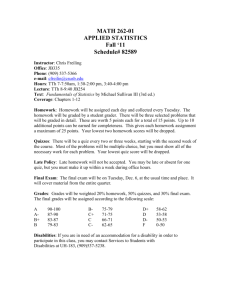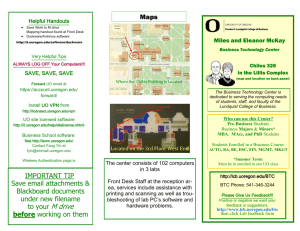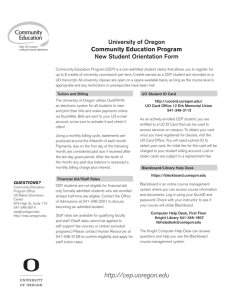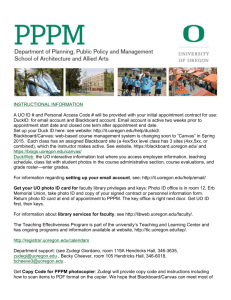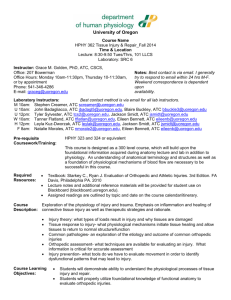Math 105 Syllabus - University of Oregon
advertisement
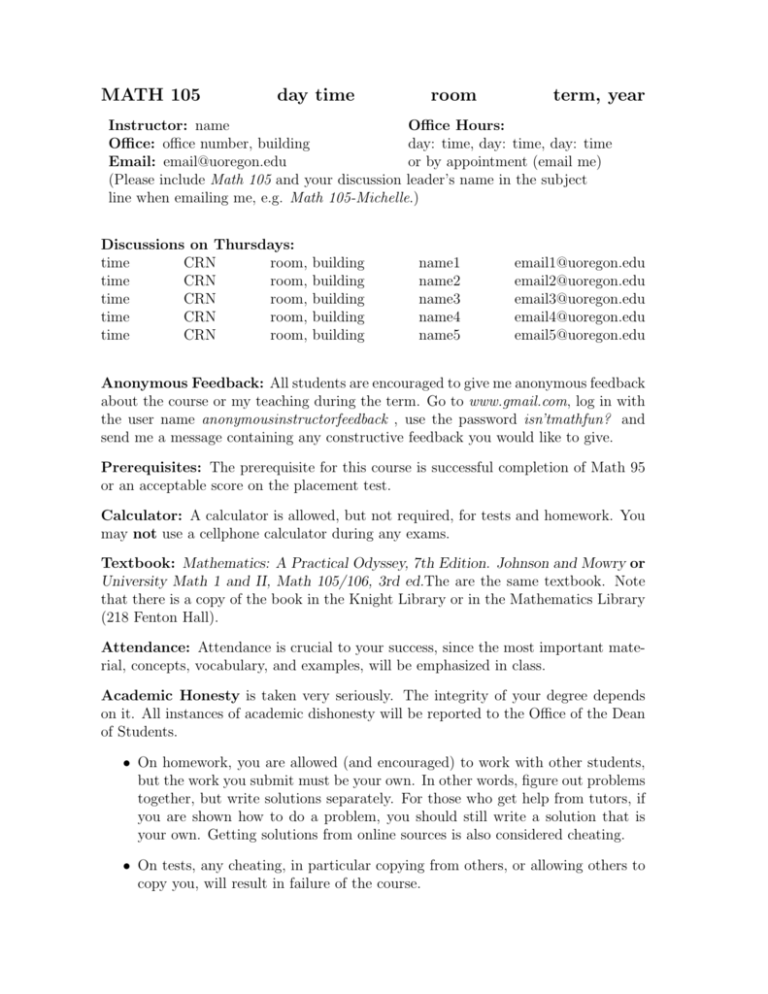
MATH 105 day time room term, year Instructor: name Office Hours: Office: office number, building day: time, day: time, day: time Email: email@uoregon.edu or by appointment (email me) (Please include Math 105 and your discussion leader’s name in the subject line when emailing me, e.g. Math 105-Michelle.) Discussions on Thursdays: time CRN room, time CRN room, time CRN room, time CRN room, time CRN room, building building building building building name1 name2 name3 name4 name5 email1@uoregon.edu email2@uoregon.edu email3@uoregon.edu email4@uoregon.edu email5@uoregon.edu Anonymous Feedback: All students are encouraged to give me anonymous feedback about the course or my teaching during the term. Go to www.gmail.com, log in with the user name anonymousinstructorfeedback , use the password isn’tmathfun? and send me a message containing any constructive feedback you would like to give. Prerequisites: The prerequisite for this course is successful completion of Math 95 or an acceptable score on the placement test. Calculator: A calculator is allowed, but not required, for tests and homework. You may not use a cellphone calculator during any exams. Textbook: Mathematics: A Practical Odyssey, 7th Edition. Johnson and Mowry or University Math 1 and II, Math 105/106, 3rd ed.The are the same textbook. Note that there is a copy of the book in the Knight Library or in the Mathematics Library (218 Fenton Hall). Attendance: Attendance is crucial to your success, since the most important material, concepts, vocabulary, and examples, will be emphasized in class. Academic Honesty is taken very seriously. The integrity of your degree depends on it. All instances of academic dishonesty will be reported to the Office of the Dean of Students. • On homework, you are allowed (and encouraged) to work with other students, but the work you submit must be your own. In other words, figure out problems together, but write solutions separately. For those who get help from tutors, if you are shown how to do a problem, you should still write a solution that is your own. Getting solutions from online sources is also considered cheating. • On tests, any cheating, in particular copying from others, or allowing others to copy you, will result in failure of the course. Course Goals: The course is a survey of three topics that require mathamatics and are relevant to our lives. The first topic is Logic. By the end, the students should be able to: • Distinguish between inductive and deductive reasoning • Use Venn diagrams to determine the validity of a syllogism • Translate between English statements and statements written using logical connectives: implies, and, or, not • Use truth tables to determine the validity of an argument • Use truth tables to determine when two arguments are logically equivalent The second topic is Counting. By the end, the students should be able to: • Use the language of sets • Describe the union, intersection, and complement of sets • Represent relationships between sets using Venn diagrams • Determine the correct counting method a problem requires • Use factorials, permutations, and combinations (where appropriate) to solve a counting problem. The third topic is Probability. By the end, the students should be able to: • Use the terminology of probability • Understand the rules of probability • Use counting methods to determine probabilities • Use probabilities to compute expected values • Use expected values to determine which of two events has a better chance of success • Determine when it is appropriate to use conditional probabilities • Use the correct formulas to compute probabilities and conditional probabilities • Determine when two events are independent • Use probability to solve problems in genetics and other applications Blackboard: You can use our Blackboard website to see syllabus, schedule, homework assignments, your grades and more. To access our class blackboard site go to http://blackboard.uoregon.edu/ Accessibility: The University of Oregon is working to create inclusive learning environments. Please notify me as soon as possible if there are aspects of the instruction or design of this course that result in disability-related barriers to our participation. You may also wish to contact Disability Services in 164 Oregon Hall at 346-1155 or disabsrv@uoregon.edu Homework: Homework will be collected weekly in your discussion section. Homework questions should be addressed during your TA’s or instructor’s office hours. Not all of the assigned problems will be graded. Each week, several problems will be chosen to be graded for accuracy. You must show your work to get credit. Marks may be docked if your homework is not neat. Quizzes: Thursday discussion classes will consist of a 20 minute quiz, and then a discussion about the solutions to the quiz. The quizzes are graded for effort only, not accuracy; in other words, if you show up to every discussion section and make a genuine effort on every quiz, you will receive full marks. Grading: Quizzes – 10% (every Thursday in your discussion section, graded for effort only) Homework – 20% (due every Thursday in your discussion section, the lowest HW score will be dropped) Midterm Exam – 30% (day, week 5, in class) Final Exam – 40% (day, week 11, time, location) NOTE (on all homework, quizzes, and exams): No late work will be accepted. Make-up quizzes or exams will not be offered. If there are documented, extenuating circumstances, the work will be excused. Grading Breakdown: A: 90% or better, B: 80% -89%, C: 70%-79%, D: 60%-69%, F: below 60%. Plus grades will be awarded when the last digit is 8 or higher (98%-100% is an A+). Minus grades will be given if the last digit is either a 0 or 1. Your final percentage will be rounded to the nearest whole number. You must get at least 70% to receive a pass (P) grade (if you are taking this course with the Pass/No Pass option). Math 105 Term Year Tentative Class Schedule: Week 1 2 3 4 5 6 7 8 9 10 11 Sections Covered 1.1, 1.2 1.3, 1.4 1.5, 2.1 2.2, 2.3 Review, Midterm Exam 2.4, 3.1 3.2, 3.3 3.4, 3.5 3.6, 3.7 Review for Final Final Exam (on chapters 2 and 3) Discussion Quiz #1 Quiz #2 Quiz #3 Quiz #4 Quiz #5 Quiz #6 Quiz #7 Quiz #8 Quiz #9 Quiz #10 Important Dates: • Monday of the 2nd week – last day to drop without a ‘W’ • Wednesday of the 2nd week – last day to add a class • Sunday at the end of the 7th week – last day to drop the course or change your grading option to P/N. • Thursday, November 27th and Friday, November 28th are holiday in the Fall (week 9); January 19th is a holiday in the Winter (week 3); May 25th is a holiday in the Spring (week 9) Tips for Success: • attend every class • read the section of the textbook before we discuss the material in class. Even reading the first page or two helps • begin assignments as soon as they are posted • spend time on this course every day: reading ahead, reviewing notes or quizzes, completing assignments, etc. Extra Help: If you think you’ll need extra help, get a tutor right away. Check with Teaching and Learning Center (room 68 PLC). Teaching and Learning Center also maintains a free drop-in lab with tutors starting from week 2 (room 72 PLC, Mon-Fri: 9-4.) You can read about their services on their site http://tlc.uoregon.edu/ Expectations I expect you to: • submit work on time • arrive on time, and to minimize the disturbance if you arrive late • ask questions • provide feedback about the course (anonymously or otherwise) • participate in class • be respectful and courteous towards you classmates (eg., chatting during class distracts other students, and will not be tolerated) • come to class prepared (eg., reviewed content from last class, attempted the homework, etc) • spend approximately two hours outside of class on homework, review, etc for every one hour spent in class • take responsibility for any course content covered when you miss a class • attend office hours or make an appointment with me if you would like help You can expect me to: • arrive on time to class • be enthusiastic about the material and about mathematics in general • be available to provide help, support, and advice • reply to email in less than 24 hours (typically much less than 24 hours) • consider and respond to all feedback about the course • return work no more than one week after it has been submitted • make adjustments to the classroom environment throught-out the term according to the needs of the class Notes for the instructor: (mostly borrowed from Mike Price, with many thanks) • The course coordinator is David C Steinberg: dcstein@uoregon.edu • There are a variety of syllabi online (http://math.uoregon.edu/syllabi/), which are definitely worth checking out • The course is less modular than Math 106 and 107. Math 105 has a steady narrative of gaining tools necessary for the application of probability. Because it has a reasonable narrative, a cumulative final exam makes sense during the registrars scheduled time. • Two exams and a cumulative final would suit the course in theory, but there is no clear opportunity for a second midterm exam. If you find a division point that makes sense to you, consider giving a second midterm. • I let students have a note card on their exams. Im not so concerned with them memorizing the formulas for set theory or probability; Id like to see them applied and interpreted successfully. • Consider having homework due twice per week, it works out to almost exactly one section per turn-in that way. • Math 243 covers course content similar to Chapter 4 in this textbook. This content is optional, but should not be introduced to the exclusion of thorough, applied practice with logic, sets, and probability.


